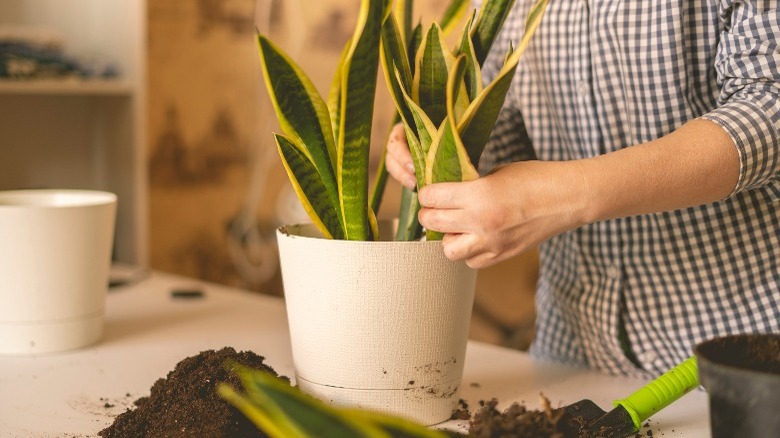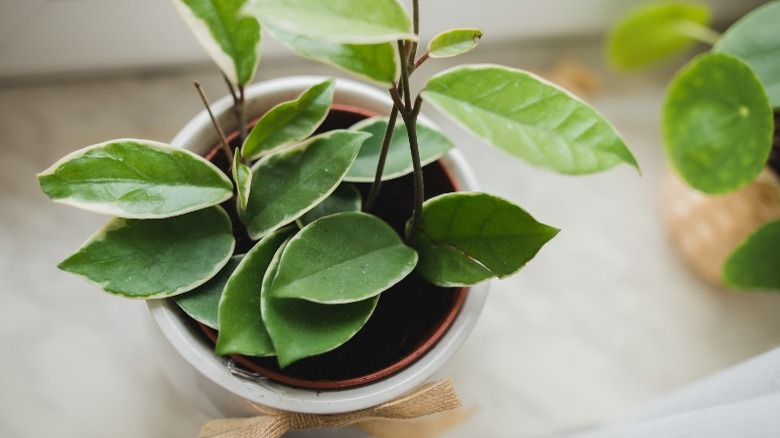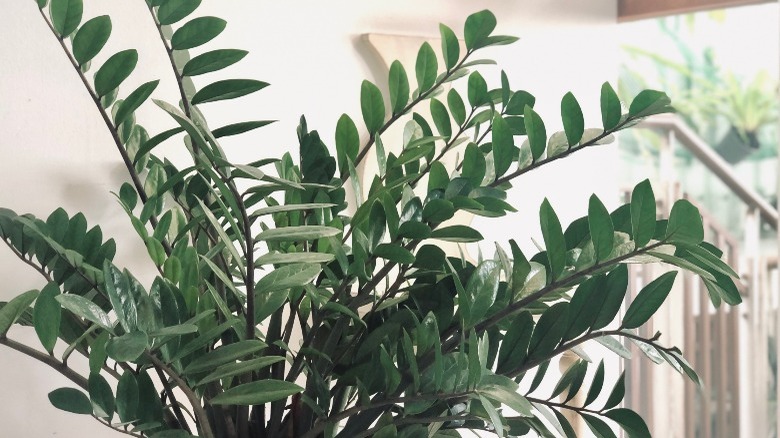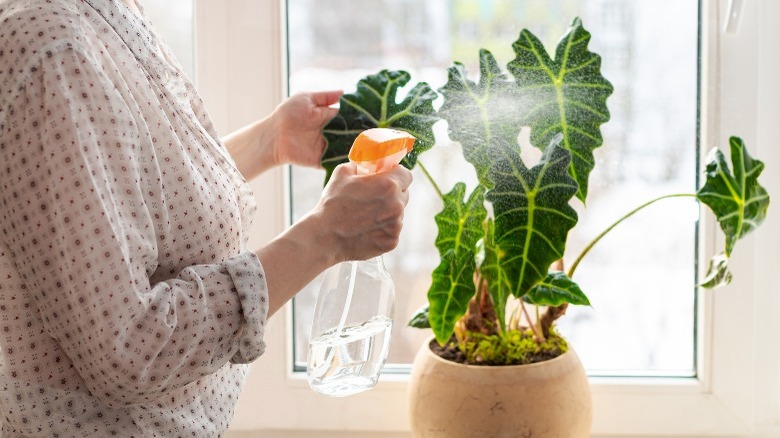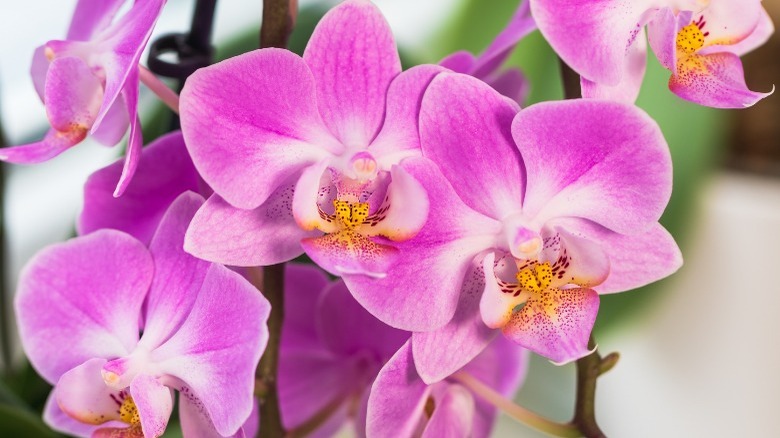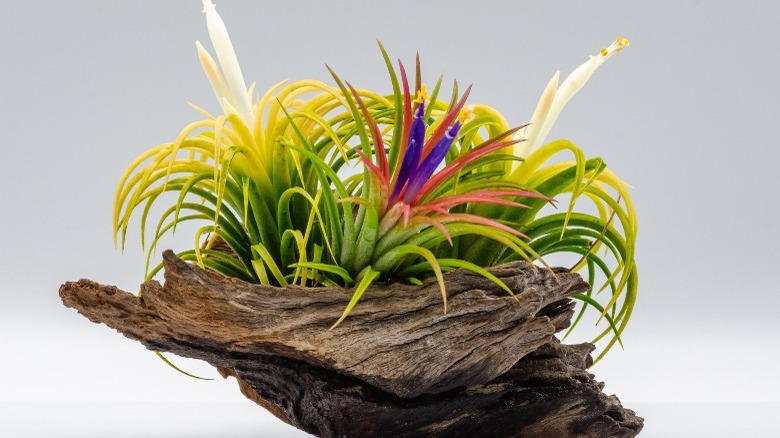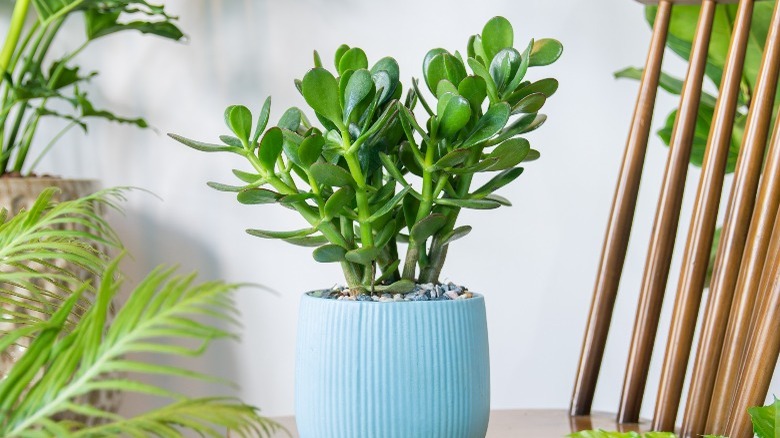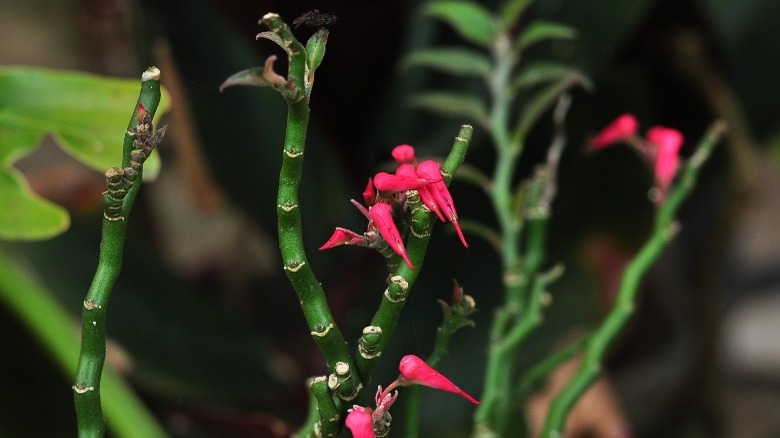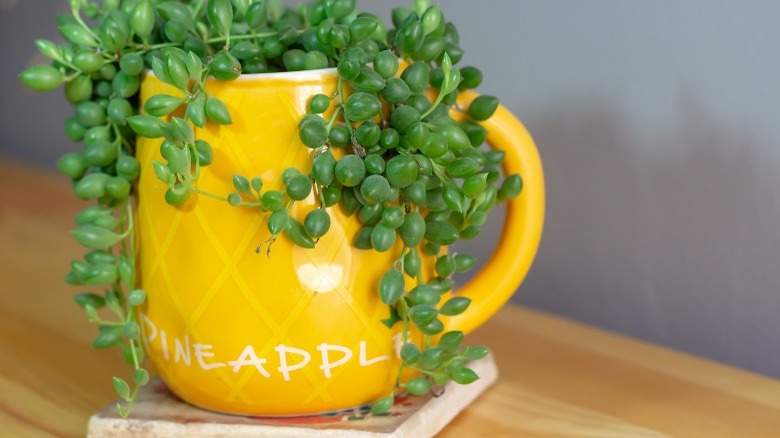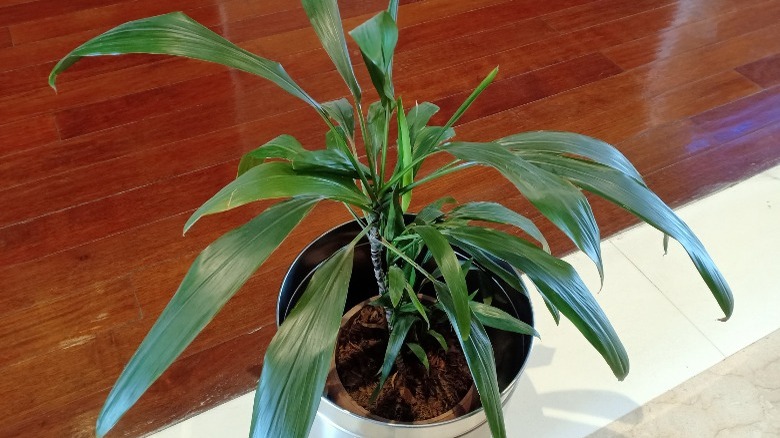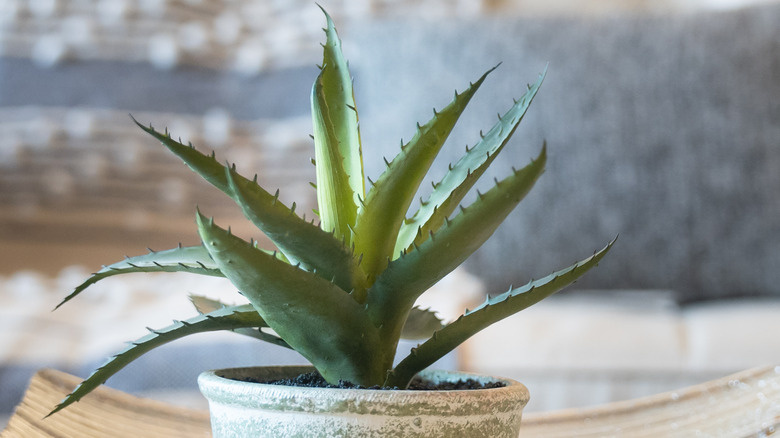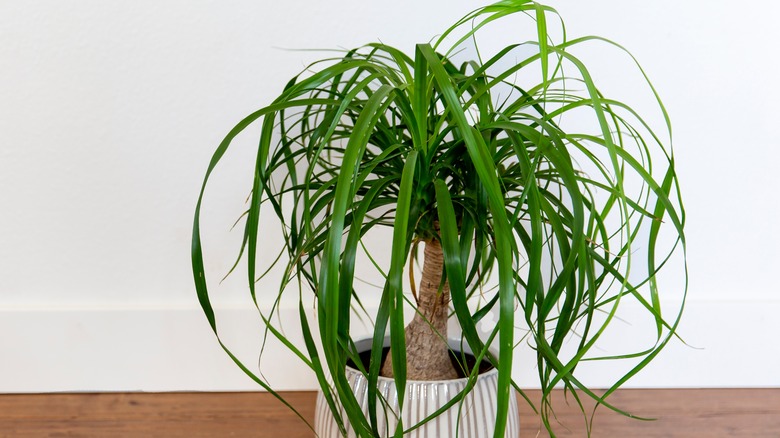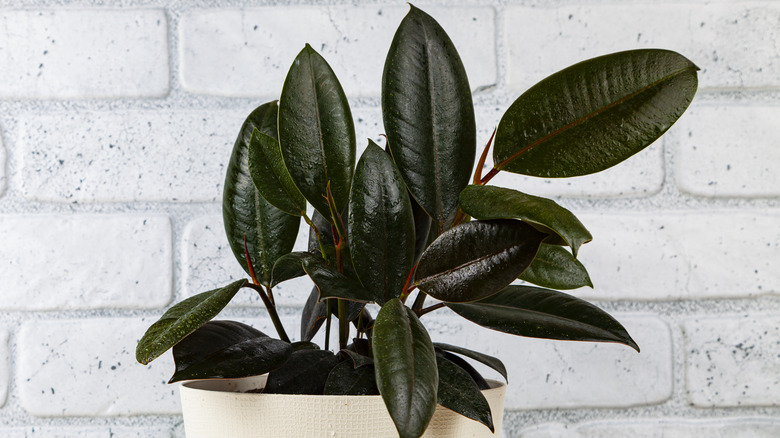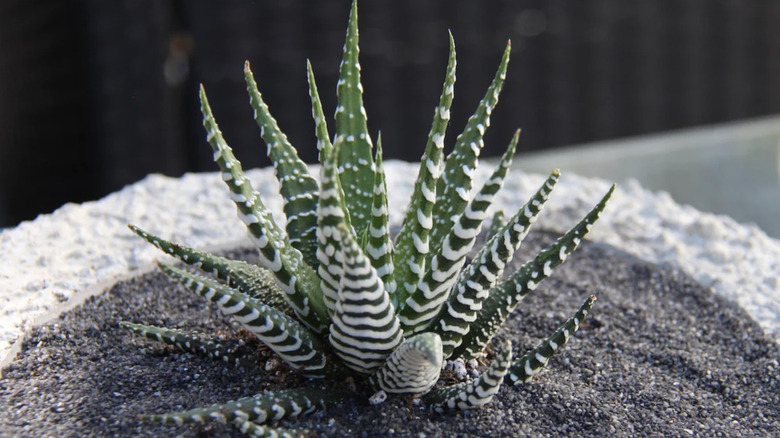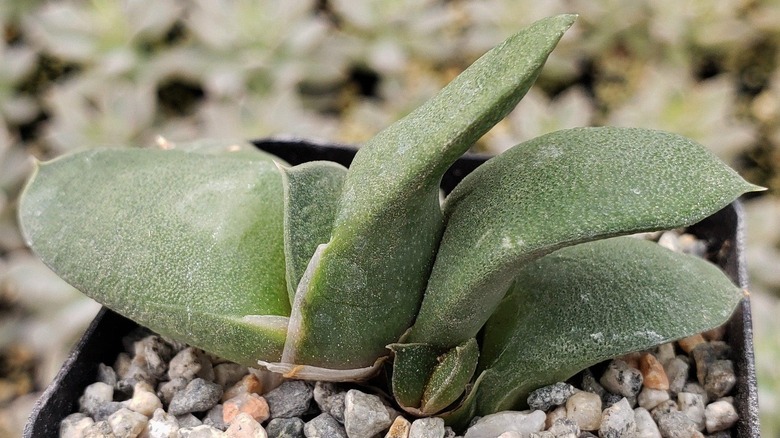Houseplants That You Barely Need To Water
We may receive a commission on purchases made from links.
People with green thumbs recognize the importance of stacking the odds in their favor when choosing indoor and outdoor greenery, so low-maintenance plants are ideal. But no matter where they are planted, almost all of them need at least some sunlight and water to survive. However, this doesn't mean they should bake in the sun's rays or get drenched with H2O every day. Reaping the benefits of healthy houseplants need not involve heavy labor. There are many low-maintenance ones to choose from and some barely need any water.
You may have heard that the human body is made up of mostly water, and the Mayo Clinic reports that the amount ranges from 50% to 70%, depending on the individual's body weight. Most humans can only survive for about three days without water. It is also essential for plants, including the ones that you keep inside your home. West Virginia University Extension claims that water makes up 95% of plant tissue and it is an essential ingredient for photosynthesis, but plants can survive and thrive for much longer than three days without getting a drink. Some need water once a week, and others can go as long as three months or longer. If you don't want the hassle of watering your entire plant collection every few days, here are the plants that barely need a drink.
The succulent snake plant
Though they have much in common, there is a difference between cacti and succulents. Both plants have thick, fleshy stems that can store water within. All cacti are succulents, but not all succulents are cacti. To be considered a cactus, a succulent must have areoles on its surface. Those small, round bumps are an identifying cacti characteristic; you'll usually see spines, hair, or leaves growing out of them.
The snake plant is a succulent as it lacks those identifying areoles, and according to North Carolina Extension, two popular species are Dracaena angolensis and Dracaena trifasciata. The Dracaena angolensis, or cylindrical snake plant, is also known as the African spear. This succulent has tubular, striped, green-gray spiky leaves that can grow from 6 inches to 7 feet tall. It produces tiny white flowers in the summer, but only when the plant is grown outdoors in most cases. The African spear does well with about two to six hours of direct or dappled sunlight and thrives in well-draining soil. You'll only need to water this succulent once a month in the winter and every other week in the summer.
Dracaena trifasciata has interesting names like good luck plant, mother-in-law's tongue, and the basic moniker of snake plant. Its thick, water-filled leaves also grow upright like the African spear's but only top off at about 4 feet. The leaves may have green, white, or yellow bands. It's a difficult-to-kill plant that prefers two to six hours of direct sunlight or low light per day. Allow the soil to dry out between the waterings, and remember to cut back even more in the cold weather when the plant is dormant.
Royalty in the making: Hoya Krimson Queen
The second succulent on this list of low-maintenance houseplants is the hoya in general and the Hoya Krimson Queen in particular. It is a cultivar of hoya, called a wax plant, and is known for its long vining stems. Other notable characteristics include full, heart-shaped leaves with white or pinkish edges and pretty, fragrant flowers. Hoyas can grow as high as 6 feet and prefer soil with an equal ratio of peat moss and orchid bark.
The Hoya Krimson Queen only needs medium sunlight, and like other houseplants, the more sun it gets, the more water it will need. Be careful not to overwater this pretty plant — the two inches of topsoil must be completely dry before you water it. Place it in an area that gets partial shade, and you'll only need to water it once a month.
Hoyas can be somewhat stubborn when it comes to flowering, though. PennState Extension notes that these plants grow slowly and that the blooms also take their sweet time. If and when you see flowers starting to form, leave the plant alone. Do not give it any extra water, and avoid moving or otherwise adjusting the plant. It does not need extra attention — all it needs is time.
Again, Krimson Queen is just one variety of hoya. By Brittany Goldwyn feels that Hoya carnosa jade, Hoya carnosa Chelsea, and Hoya carnosa compacta make good beginner, low-maintenance houseplants. Just remember that most varieties are sensitive to overwatering. As a guideline, it's best to water them once every two weeks in the spring and summer and every three to four weeks in the fall and winter.
The appropriately-named ZZ plant
Uli Lorimer is Brooklyn Botanical Garden's native flora garden curator, and he calls the ZZ plant indestructible. It can be grown outdoors in warmer weather but should be brought inside when temps dip below 60 degrees. This houseplant grows up to 3 feet tall and has compound, shiny green leaflets. And according to Missouri Botanical Garden, this plant produces small white flowers enclosed in spathes (sheath-like, green spikes). The ZZ stands for its botanical name, Zamioculcas zamiifolia, but you might think the acronym refers to how little water this plant needs — is it sleeping?
ZZ plants are neither cacti nor succulents, as they belong to the aroid family. There are 3,700 species of these plants, and all have flower structures known as the spadix. The insides of aroid leaves contain toxic, milky sap, so keep small children and pets away. McDonald Garden Center adds that aroids grow quickly indoors and have leaves that come in a variety of colors and sizes. They do well indoors with low or bright light and have thick, waxy roots.
Iowa State University Extension claims that the ZZ plant can tolerate prolonged dry periods and rarely succumbs to diseases or insect infestations. Keep your ZZ on the dry side, giving it some H2O every three weeks or so. Do not water it again until the soil is good and dry.
The elephant ear alocasia
Native to northern New Guinea through the Bismarck Archipelago, alocasia grows upright and sports thick, dark green leaves. These houseplants are anything but basic, though, and have interesting varieties. There are about 100 recognized alocasia species, but the elephant ear is one of the best-loved and easiest to care for.
These large plants can grow up to 15 feet tall and spread out to 8 feet wide, with attention-grabbing, wavy-edged leaves that can be up to 6 feet long and 4 feet wide (via Missouri Botanical Garden). The impressive leaves also have lighter, prominent veins, and you may see flowers or small red fruits sprouting from time to time. Both form inside the plant's pale green spathes or spadices (plural of spadix).
Elephant ear is an easy plant to care for as long as it gets bright, indirect light for at least two hours a day. You can let the top third of the soil dry out between waterings during the warmer months. Reduce this timing in the fall and winter when the plant goes dormant. For the best chances for success, use room temperature water (fresh and bottled is best), and keep the plant out of dark areas. Elephant ear plants can also be fertilized every few months to promote strong, healthy leaves.
Exotic, easy-care orchids
There are close to 30,000 species of orchids, and legions of loyal fans belong to organizations around the world. These tropical flowers are beautiful to behold and easier to care for than you might think. Orchids can go for long periods without water because they have spongy, thick roots that absorb moisture. Their central stems contain both female and male reproductive parts, and most are classified as epiphytes — plants that grow without soil.
Not all orchids make for low-maintenance houseplants, though. To err on the side of caution, PennState Extension suggests two genres: Phalaenopsis (moth orchids) and Paphiopedilum (slipper orchids). Longwood Gardens claims that Phalaenopsis is the most common kind of orchid, and explains that these plants have dark leaves on either side of their long, tall stems. Those leaves are wide and flat, with a horizontal profile. Phalaenopsis flowers can be purple, violet, and in rare cases, violet-blue.
Phalaenopsis does best with warm temperatures from 60 to 85 degrees and low light. They need more humidity than other kinds of orchids and can thrive with artificial light. Slipper orchids prefer low light, temperatures ranging from 60 to 90 degrees, and east or west windows — artificial light is also fine.
Orchid watering frequency depends on the type of medium it is planted in. Chicago Botanic Garden posts that orchids grown in moss retain more moisture and can take a drink every two to three weeks. You'll need to water ones planted in wood chip mediums more often. If you're uncertain, the American Orchid Society recommends trying the pencil trick: Just take a sharpened pencil and insert it into the moss or wood chip medium. If the pencil tip darkens, the orchid is not thirsty.
Air plants need little water and no soil
If you're really on the lazy side, an air plant could be a great way to have greenery inside your home with almost no work at all. Farmer's Almanac explains that these cool little plants are epiphytic — instead of depending on water, they survive on moisture in the air. Air plants can be placed inside any small, shallow container, but only pick ones that don't retain any water. You needn't add any potting soil and can leave the plant on a countertop or put it in a hanging glass globe. If you need to secure the plant to anything, use some gardening wire or fishing line.
Air plants do well near bright windows as long as there is no direct sunlight. You can try putting yours in a kitchen or bathroom window with indirect light, where the plant can benefit from some humidity. You don't ever have to water it, but it will be happy if you mist it every once in a while. Only use room temperature H2O, trim off brown leaf tips, and cut off completely brown leaves. Retailers like Air Plant Supply Co. offer these little wonders, and you can find them sold with their growing mediums, inside small containers, or standalone. Two good varieties to try are mesic and xeric air plants.
The jade plant is a real gem
As one of the more common houseplants, jade is a card-holding succulent that can brighten up your home. Wisconsin Horticulture Division writes that these plants grow slowly, have smooth, shiny, egg-shaped leaves, and prefer dry, warm conditions. Like other succulents, jade stores water inside of its roots, stems, and leaves, so it doesn't need to be watered that often. The leaves grow in pairs on opposite sides and can get to 1½ inches wide and 3½ long. The edges might turn reddish if there is adequate light.
Give your jade plant at least four hours of direct sun or indirect, bright light for the best results. These tough houseplants only need to be watered every two to three weeks, but it is important to check them regularly. Overwatering symptoms include falling leaves, yellowed, soft leaves, or even dry leaves. And when a succulent like jade is under-watered, the signs include dried-out soil, roots forming above the soil, or wrinkled or curling leaves. If you're unsure, feel the soil with your fingers.
The devil's backbone won't give you any problems
Also known as the zigzag plant, the devil's backbone has a shrub-like growth, a dramatic appearance, and no problem surviving in dry conditions. It is native to the Americas, but is classified as an invasive species in certain parts of Asia, Oceania, and Africa. The devil's backbone is a self-sufficient succulent, but it does need plenty of sunlight and well-draining soil. These plants will not thrive in wet soil. Though drought-tolerant, you don't want to let them go bone-dry. It's best to keep their soil moist, watering once the top two inches of dirt go dry. However, you barely have to water it during winter since it doesn't need as much water when it's dormant.
Devil's backbone plants prefer medium or bright light, and if left in low light, the foliage may start to fade. These plants can be fine for long periods without water, but be careful. If you wait too long, its lower leaves may start to drop. These user-friendly houseplants do not require fertilizer, but if you want yours to grow faster, you can add some. They also purify the air but be sure to keep them away from pets and children as they can be toxic.
String-of-pearls or green peas? You decide
Here is an interesting perennial succulent that looks like a green string of pearls — or wait, does it look more like pea vines? According to Wisconsin Horticulture Division, this plant belongs to the daisy family, and those round, little green balls are leaves. Each of the 1/4-inch diameter "peas" stores water, so there is less water evaporation and, as a result, less need for watering. These plants look nice in hanging baskets, with the trailing stems spilling over the sides. Otherwise, they can be grown in flat dishes and spread out like mats.
String-of-pearls have sensitive roots that should never be overwatered. For the best results, don't water the plant at all in the wintertime and only do so once outside temperatures start to rise. If you wait too long, though, the leaves might end up looking like ... dried peas. Place your string-of-pearls plant in bright direct or indirect light and in a warm location to help the planting medium dry out between waterings. Too much liquid can lead to root rot, so use a well-draining soil mix (a houseplant cactus mix can work) and clay containers since they are more conducive to water evaporation.
The classic cast iron plant
Talk about resilience. According to the University of California Botanical Garden, the cast iron plant was strong enough to survive the ethylene found in indoor gas lighting in the late 19th century. It also does well in other challenging conditions like filtered light, dark shade, and minimal water conditions. Cast iron plants (also called aspidistra) have something in common with orchids — both plants have female and male reproductive organs. Cast iron plants do fine in sandy, loamy, and clay soils, and enjoy full shade and semi-shaded areas. Cast iron plants have glossy, dark green leaves that can grow from 2 to 3 feet long and cream/purple-colored flowers given the right growing conditions.
This happy houseplant also tolerates different temperature ranges and does not need to be watered often. Use a well-draining, peaty houseplant potting mixture, and your cast iron plant should do well if kept out of direct sunlight. It's best to let this plant's soil dry out in between waterings, but if you're not sure, just use that pencil test.
The lily of the desert aloe vera
Well known for its far-reaching popularity, the aloe vera plant is used worldwide for medicinal and decorative purposes. Originating from the Arabian peninsula, these plants are part of the Asphodelaceae family and are grouped with almost 400 other species of succulents. They're recognizable by their thick and sharp-toothed leaves that branch out in a basal rosette arrangement and the tubular red-orange flowers that form on the tips of their leaves. The reason that their leaves are physically plump is that they retain water by natural instinct. Since this plant is native to arid areas, it is accustomed to holding water in preparation for droughts. Due to this natural instinct, the plant hardly requires any watering on your part.
Water them every two to three weeks or when the top third of their soil feels dry. You should fertilize these plants even more sparingly— less than once per month with half-strength formula in the spring and summer. Remember that they grow best in spaces that imitate desert conditions with bright sunlight and temperatures above 55 degrees Fahrenheit. A west or south-facing window with unobstructed natural light is ideal, although you can also invest in artificial grow lights to give your aloe vera the sustenance it needs.
The stylish ponytail palm
The Beaucarnea recurvata are more commonly known as "ponytail palms," and they have a deceptive name, for these plants aren't classified as a tree nor within the same family as any palms. Instead, these miniature palm tree look-a-likes are in the family Asparagaceae, alongside other succulents like agave, yucca, and jade plants. They have bulbous stems that point upward like a tree and thin out into a fan of long hair-like leaves, which is where their name, "ponytail palm," originated. Since they grow naturally in semi-desert areas in Mexico, their thick stems serve a purpose. Much like other succulents and drought-resistant plants, this species stores water at the base of its stem, meaning it needs little watering throughout the year.
These plants should be watered deeply but very infrequently, giving them time to dry out in between watering sessions. To do this correctly, fully soak your plant, and allow all excess water to drip out through a drainage hole at the bottom of the pot. Then you must leave the plant alone for two to three weeks until watering in again. In addition to sparse watering practices, you should plant your ponytail palm in cactus potting mix and place it in direct sun.
The NASA-tested rubber plant
Rubber plants, also known as Ficus robusta, were part of a 1989 NASA clean-air study that tested many popular household plants. The study revealed that these plants play a minor role in removing air pollutants around your home, and with little work on your behalf due to their self-sufficient and resilient nature. When it comes to watering practices, it's better that you accidentally under-water these plants rather than over-water them. Unlike many other plants on this list, rubber plants are not succulents; they are evergreen tropical trees in the Moraceae shrub family.
Even though they aren't succulents, this species needs far less water than most houseplants. Depending on your house's conditions, you may need to water them once every one to two weeks or wait slightly longer in between sessions. You'll know you're giving them too much if their leaves start to turn yellow. If this occurs, hold off on the hydration until they fade back to their healthy green. Aside from limited watering, these Asia-native plants prefer bright light and well-draining, acidic soil.
The zebra cactus with bold white stripes
Recognizable by their dark green leaves with contrasting white striped patterns, zebra plants, or Hawthoria fasciata, is a South African species from the Asphodelaceae family. Their remarkable leaves are their main appeal from an aesthetic standpoint, although the patterns vary between different types of Hawthoria. Some have smooth, glossy leaves, while others are rigid with small bumps forming lines across them.
These plants prefer high humidity levels due to being native to naturally humid climates, but they require infrequent watering throughout the year. To foster an environment that ensures your plant has lush green leaves and vibrant flowers, you should water them with soft water every three weeks or when the top quarter of their soil feels dry to the touch. Be careful not to pour the water in the center of the plant, also known as the crown, but around the outside. Watering in the center creates a ripe habitat for rot, which can kill your plant. In addition to giving them their recommended water intake, you should place them in indirect, low light and make sure their room stays above 65 degrees Fahrenheit. It's easy to tell if you've placed them in a spot that gets too much sun because their leaves will get dry at the tips. If this occurs, you should move them further from the window or partially close your blinds or curtains.
The striking ox tongue succulent
Found among the grasses of South Africa is the popular Gasteria "ox tongue" plant. These succulents share a family with aloe and Hawthoria, and they are known for their resilience to various lighting, climates, and soil types. Don't expect this plant to grow very large, for they mature slowly and often only reach heights of two to four inches tall. Other than their small size, they are recognizable by wedge-shaped leaves that grow in a rosette arrangement. These leaves are thick for holding water reserves and are often covered in white dotted patterns.
These plants are easy for beginners to grow since they can survive without caretaking for weeks at a time. The most important care tip to keep in mind is that you don't overwater them. Most of these plants will only need watering once per month, though this may need to be adjusted depending on how much sun they receive. Make sure you place your ox tongue in a location that receives direct sunlight for a few hours of the day; however, they should also have some shade to keep their leaves from getting sunburned. You can easily add an ox tongue to a growing collection of succulents since they thrive alongside other plants that prefer similar sunlight and watering techniques.

